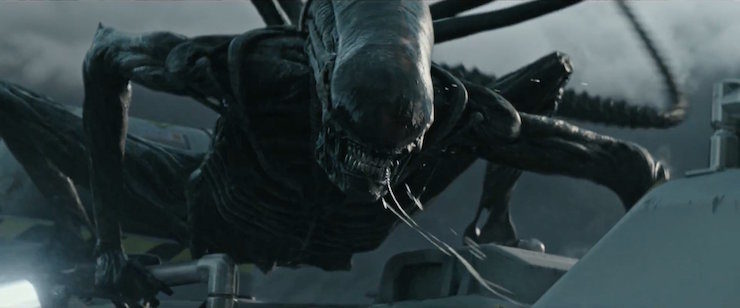It’d be very easy to look at Alien: Covenant with the wrong sort of fear and trepidation, or to simply dismiss it without giving it a chance. It’s a possibly unnecessary sequel that ties together two series/storylines set in the same universe, has a near impossible job to do fixing the mess left by its predecessor, Prometheus (the not-quite-prequel to the earlier films), and is operating at a serious goodwill deficit where its core fandom is concerned.
But you know what? Let’s be positive. Let’s look under the hood—the terrifying, chitinous, bio-mechanical hood—of these movies and see where they stand as a franchise as we head in to Alien: Covenant. What are the key concepts that tie all of these movies together, the narrative webbing holding up the complex, resinous hive that is the Alien franchise? What makes these stories work?
Well, first off there’s the titular alien. And that’s the most problematic feature, so let’s get it out of the way first: the alien, or Xenomorph, has been progressively less well served in each instalment of the franchise precisely because of the perceived need to add elements to make it seem new and novel and interesting. As presented in Alien and Aliens—which I’d argue can be seen as two halves of one epic movie almost as much as the original Terminator duology—the role of the alien is brutally simple:
- The eggs are laid by a Queen
- The eggs contain facehuggers that lay dormant until a host approaches.
- When that happens, they attack the host and lay an embryo down their throats.
- The embryo feeds off its host and rips its way out of their chest.
- It then grows into a full-sized Xenormorph, with superhuman strength and acid for blood, that serves its Queen until its killed.
Once we move beyond the original two movies, things get more complicated. Alien3 introduces the idea that when a Queen dies, a Facehugger will lay a Queen embryo in the nearest host, which secretes a pheromone other Xenomorphs can sense and know to keep the host alive. It also deals more overtly with the idea that the Xenomorph takes on elements of its host’s genetic structure. Human-created Xenomorphs are angry eight-foot warrior ants. Dog-created Xenomorphs are athletic and wiry.
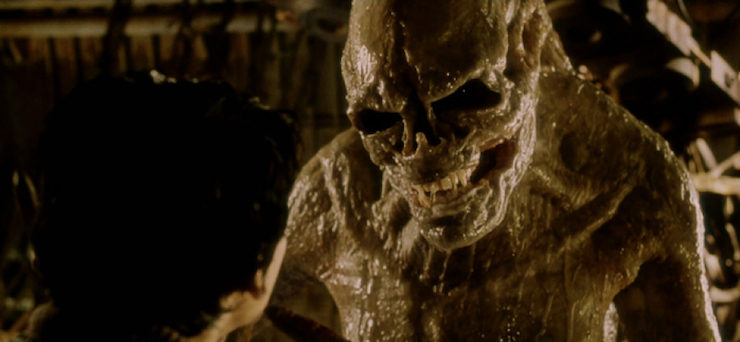
The same is basically true of Alien: Resurrection, although that does fold in the idea that the DNA of the host and that of the Queen embryo becomes intertwined during the process. That gives us the definitive franchise low point, with the skull-faced alien/human hybrid and the “…MAMA” heard around the world. It’s a catastrophically bad idea, executed very unsuccessfully. But, in spite of the way it plays out in the fourth film, it actually folds back into Prometheus and the biological tool/weapon that the Engineers are so incredibly bad at using. It doesn’t excuse the newborn Hybrid in the slightest but, intentionally or not, it does provide a possible franchise-wide context for the skull-faced elephant in the room.
The black goo is essentially feral life. It SURVIVES, no matter what, in a frantic protean sprint up the evolutionary scale. That’s best demonstrated in Prometheus’ skeeviest sequence, in which World’s Most Terrible Scientist and full-time anti-Synthetic Bigot Charlie Holloway ingests a drop of the goo thanks to David the Synthetic. That leads to drunken pity sex with Doctor Elizabeth Shaw, Charlie dying in fairly short order, and Elizabeth finding out she’s pregnant not long afterward. That, in turn leads to Shaw cutting what seems to be an octopoidal foetus out of her abdomen a few hours later. The creature grows to a frankly horrifying size, then lays an egg down an Engineer’s throat. That in turn gives birth to a pseudo-Xenomorph called the Deacon which, thankfully for all concerned, is left behind when Shaw and David flee the planet and the credits roll. It’s pretty much Prometheus’s lowest point, reducing an interesting heroine down to a mobile womb to forward the plot, such as it is. Worse still, it muddies the waters of the Xenomorph’s life cycle to an almost impossible degree.
As things stand right now, we have no idea how the Deacon evolves into the alien from the previous movies. Which are now in the future of this franchise, since Prometheus was a prequel (of sorts. At the very least, it’s safe to say that it takes place at an earlier time in the same universe as the Alien films). Like I say, this is kind of complicated.
What seems likely, judging by the footage from Covenant, is that the Engineers are a vital part of the process. There’s an implication David has perfected his work with the black goo and the short film The Crossing all but states outright that he carpet bombs the Engineer homeworld with the stuff. Whether that means the Xenomorph’s purest form is actually derived from their creators is unclear. It’d certainly be poetic, but if there’s a weak link at the point where the Alien films and Prometheus meet, this might be the flimsiest.
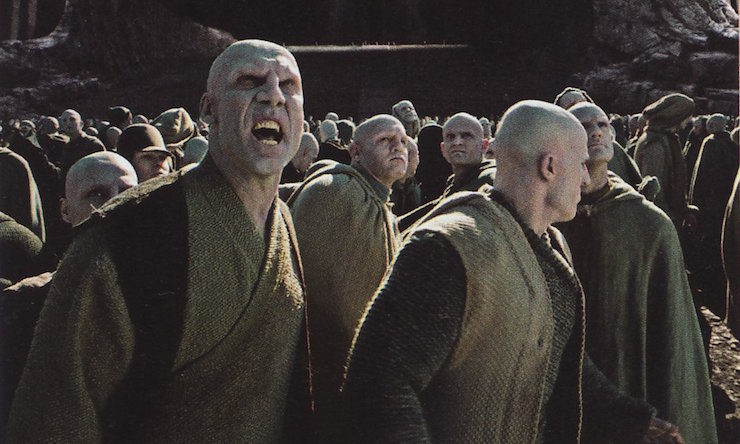
So what else do all these movies have in common? Corporate shenanigans! It’s the Cyberpunk/dystopian SF trope that didn’t so much step across into real life as add a TM on the end of everything and charge us for it. The Weyland-Yutani Corporation is a common factor through all the movies, (except for Alien: Resurrection, although it does come up in the novelization of that film). They finance the Prometheus’ mission and, it seems, the Covenant’s, too. They send the Nostromo to LV-426. They later terraform LV-426 and quietly send wildcatter prospectors to investigate the Nostromo landing site, and they run the Fiorina 161 penal colony.
Why?
Weyland-Yutani is after the same thing the Underpants Gnomes want: profit! Or perhaps, at least at first, immortality. Prometheus gives with one hand and takes with the other, here—the idea that Peter Weyland wanted to play God and used his own synthetic children to seek out what he hoped would bring him immortality is really interesting. The way it’s played out is not, however, and Guy Pearce under bad old man makeup is second only to “DIY C-Section Fun Time” and “Black Goo Make-Up Sex” as the lowest points of that movie.
But in spite of the poorly executed origin story, it does give the series its second monster: Weyland-Yutani. And more interesting still, it sets up a narrative in which this monster is slowly changed and is gradually defined by the parasitic lifeform it fixates on: the Xenomorph.
That obsession and its evolution is best shown through the franchise’s Synthetics. This is where Prometheus and, it seems, Covenant, do something really interesting that changes every movie that follows them for the better. Especially Alien: Resurrection.
Prometheus establishes that David’s principle objective is to help Peter Weyland live longer. The trailers for Covenant show several scenes in a white room with very little furniture and what seems to be both David, and his “younger” brother, Walter, interacting. And as we said, The Crossing seems to show David carpet bombing the Engineers with the Black Goo.
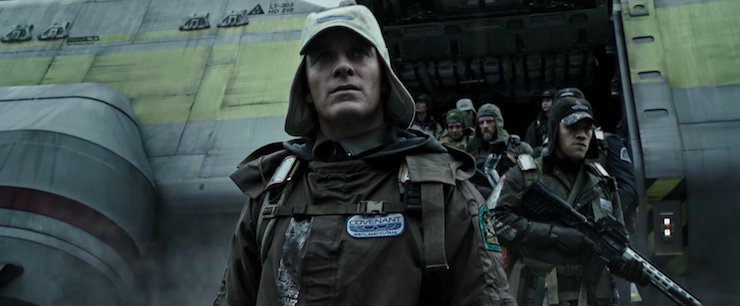
So, the Synthetics are front and centre in the creation of the Xenomorph but they also seem to be haunted by it, and by Peter Weyland, as well. David and, it seems, Walter have Weyland in the back of their heads like a belligerent King Hamlet demanding they protect their ailing idiot “father.” By the time Alien rolls around, Weyland’s personal agenda has given way to the Xenomorph as the most dangerous intellectual property in history. It’s no longer personal. It really is business.
Business on a sufficiently massive scale that by Aliens, an entire colony is viewed as a justifiable sacrifice by Carter J. Burke. More interesting still is that this newfound human ruthlessness is no longer present in the Synthetics. Bishop is aware of the Nostromo Incident and actively embarrassed by it. The reveal in Alien3 that he shares a face with his creator even plays into this. It’s easy to imagine a “back to basics” marketing campaign reassuring nervous contractors that their Synthetic crewmate definitely isn’t going to choke them with a rolled-up porno magazine. Better still, this portrayal reflects an infinitely less egotistically-driven take on human and Synthetic relations than Peter Weyland’s approach. The Synthetics of these later movies aren’t Peter Weyland’s children and are well on the way to becoming something much more interesting.
Which brings us to Annalee Call from Alien: Resurrection. Call is an Auton, a Synthetic created by Synthetics and the end point of a story that begins way back in Prometheus with the creepy, and rather dull, David. With Prometheus and Covenant now providing the origin for the franchise as a whole, we see the Synthetics develop in a manner that’s ultimately the most hopeful element of these movies. David is broken and defined by his “father.” Walter, it seems, is similar or possibly worse, a victim of David. Ash is the remorseless will of Weyland-Yutani embodied, whereas Bishop is an individual with his own ethics and beliefs. The reasons he is what he is, we can surmise, are due in part to marketing decisions—but that fact doesn’t invalidate his fundamental decency. Bishop is the first Synthetic to break free of Peter Weyland’s deathless grasp, and that’s a sign of progress to be absolutely celebrated.
Especially as it gives rise to Call. Call’s character is the best element of Resurrection and also one of its most frustrating. We get her backstory in a chunk of exposition that mostly gets lost amidst the movie’s relentlessly bad CGI and underlit sets and it’s a real shame, because she’s fascinating. Presumably the falling sales of the Synthetics after the Ash incident (which would have led to the changes which enabled Bishop’s heightened degree of freedom and decency), continued. The Autons, either as a gimmick, a cost-cutting measure, or simple outsourcing, make perfect sense in that regard. The fact no one at Weyland-Yutani imagined that they might become truly independent speaks with painful clarity to the Corporate mindset.
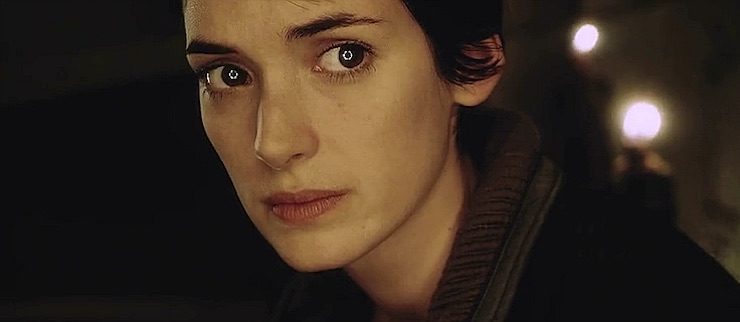
So, Synthetics built by Synthetics. One who are completely aware of their past, of the crimes of David and Ash and the terrible old man sitting in the back of their parents’ heads. And, more importantly, not sitting in the back of their own. The Autons are the literal and metaphorical anathema of the Xenomorphs; principled, clear-eyed, ruthless, and painfully aware of the damage they’ve done and the need to protect the people around them.
Doesn’t that sound like the basis for an amazing movie? Maybe we’ll get to see it one day.
The final element linking all of these films together is the people, the characters. The first crew we meet, in this timeline, are the crew of the Prometheus. Thanks to edits which seem almost purposely designed to portray them as idiots, they really do seem like the finest scientists the lowest-bidding contractor could provide for the mission. A cartographer who gets lost inside his own map. A biologist who decides to prod a clearly dangerous-looking alien creature. An archaeologist who, at literally the first chance he gets, takes his helmet off on an alien world, throws a tantrum because the intelligent life he’s found is dead, and bigots his way across every interaction with the ship Synthetic before finally having sex and dying. Oh, and don’t even get me started on Vickers, elite corporate executive who doesn’t understand the concept of TURNING.
The Prometheus crew—Idris Elba’s Janek and his two pilots aside—are the least sympathetic cast it seems likely this franchise will ever have. They’re the only ones who, you could argue, deserve every hideous death their own idiocy brings down on them.
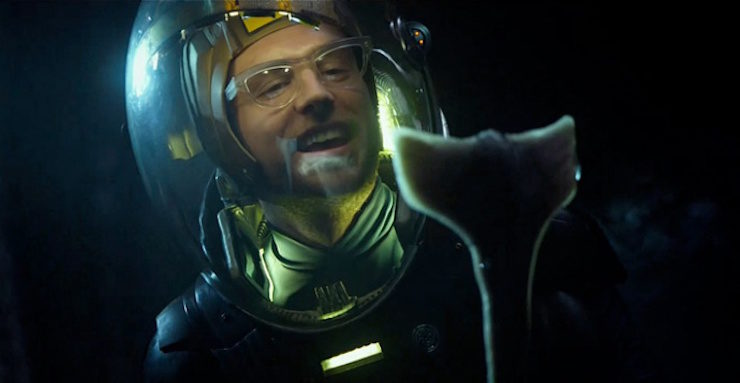
But, when placed in context, that works. Sort of.
The Prometheus crew have never faced this situation before. No one in their world has. They don’t make good choices, or even excusable ones. They die. A lot. If there was ever a place they’d fit in, or at least fit least badly, it’s at the very start of the timeline, where sheer panic and idiocy makes a certain amount of sense.
This is where Covenant absolutely has to deliver. The idea of the ship being crewed by people in stable relationships is a really smart one, adding instant jeopardy and stakes. But they can’t be idiots. Or at least, not as idiotic as the Prometheus crew almost always are. This is the second crunch point for the movie and, as with getting the Xenomorph right, it’s a big one.
Especially since the crews that follow the Covenant are so good. The Nostromo’s cheerfully dysfunctional Oil Rig Workers In Space are tremendous fun, even now. In fact, they’ve arguably aged the best, overall—they’re still relatable as resolutely normal people with a dull job they’d prefer not to have to do. When things go south they react sensibly. When they die, it’s because of shock and terrible luck far more than basic stupidity. THEY UNDERSTAND TURNING. It’s all good.
Likewise the marines at the heart of Aliens are great fun. Foul-mouthed, utterly confident, and absolutely shattered by what they find, they’re the human embodiment of a false sense of security sporting combat boots and nicknames. I rewatched the entire series recently and these two casts are absolutely in lockstep in terms of writing and performance. This is blue-collar space travel with a world-weary multiculturalism to it that still feels fresh and, at times, aspirational. Which, in the seventeenth year of the 21st Century, is actually rather sad.
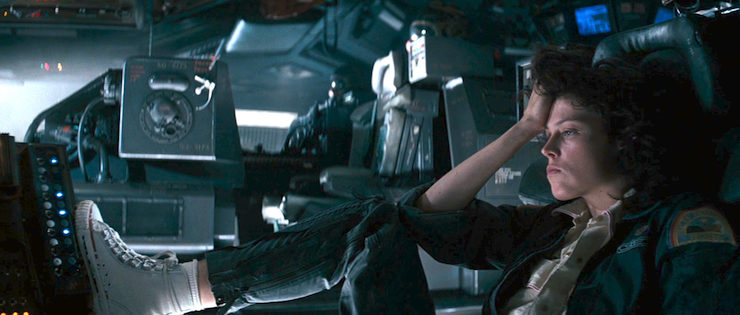
Alien3’s cast of prisoners and wardens continue that tradition, but add a welcome touch of nihilism to the proceedings. Alien3 is a film with no heroes and no hope. The prisoners, under the hyper-charismatic Charles S. Dutton, know they’re in Hell even before the Xenomorph arrives. The way they deal with that arrival, as well as the sudden presence of a woman on world, and being thrust into Weyland-Yutani’s cold corporate spotlight, feels a little more operatic in tone than the previous two movies but is no less impressive. The moment in which two prisoners collide while running for their lives and one berates the other for running with scissors tells you everything you need to know. It’s funny and oddly normal and sad, and shows just how small their world is. These men have nothing, placing them in a rarefied fictional space that suits the movie’s quasi-religious ending. From nothing, from no choice, comes the one thing none of them expected to encounter: hope. And, in Ripley’s case, peace.
Alien Resurrection’s crew of the proto-Serenity known as the Betty are the outliers, here—at least to some degree. They’re all fun, competent people who are cheerfully unpleasant, oddly charming, eminently disposable, or often all three at the same time. There’s an interesting point to be made too about how they’re indicative of how their world has changed. The first people we meet in the timeline are innocent (and frequently astoundingly stupid) scientists. The second group, in the upcoming Covenant, are idealistic colonists. The third group are basically truck drivers. The fourth are colonial marines. The fifth are prisoners, and these last, in Resurrection, are pirates. Considered in a straight line, the simple fact that the Betty’s crew exists says a lot about how ubiquitous space travel has become over the years—not to mention how dangerous. The Betty’s crew are no one’s victims, yet almost none of them make it out of the movie alive. Even here, at the far end of the timeline and with the Xenomorph practically public knowledge, it’s still an intensely dangerous and terrifying predator. Life, as another famous movie scientist once said, finds a way.
It’s easy, and often seems almost compulsory, to criticise any and all new additions to the Alien canon. There’s a lot wrong with the more recent films, individually, and it’s true that we have no promise that Covenant won’t make matters even worse. But for all that, these two sets of films share resilient DNA, and possess many strengths in those key points of connection: in the complicated history that exists between the Xenomorphs and Weyland-Yutani, more a twisted symbiosis than a battle to the death; in the fascinating evolution of the Synthetics over time, and finally, in the shifting roles of the ordinary humans at the mercy of both killer aliens and unconscionable corporate greed and obsession. Like the Xenomorph, like Ripley, like the Synthetics, the Alien movies are survivors. And, if Covenant does well, they’ll be surviving for a long time yet to come.
Alasdair Stuart is a freelancer writer, RPG writer and podcaster. He owns Escape Artists, who publish the short fiction podcasts Escape Pod, Pseudopod, Podcastle, Cast of Wonders, and the magazine Mothership Zeta. He blogs enthusiastically about pop culture, cooking and exercise at Alasdairstuart.com, and tweets @AlasdairStuart.










